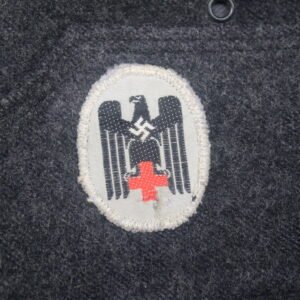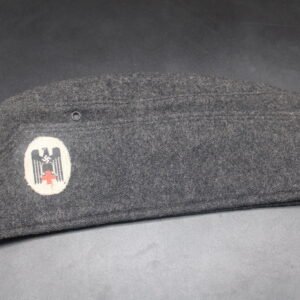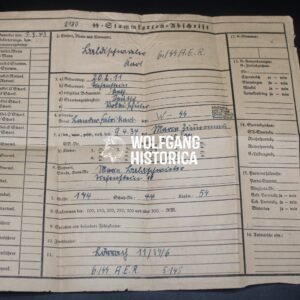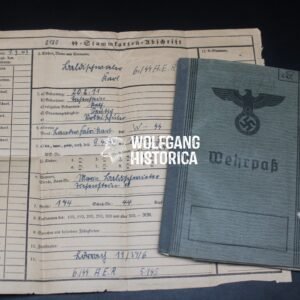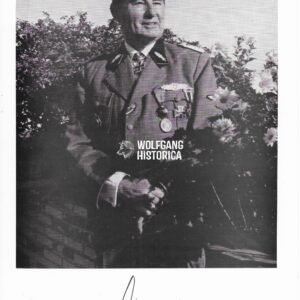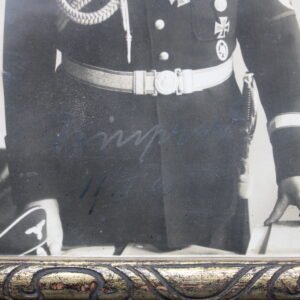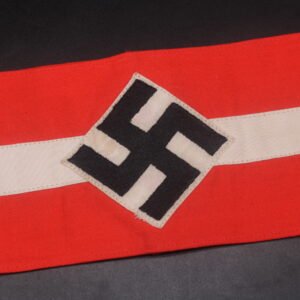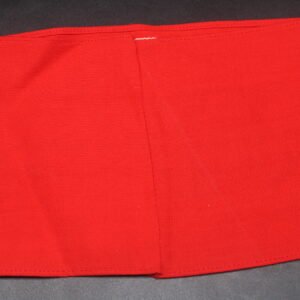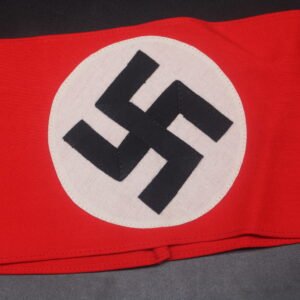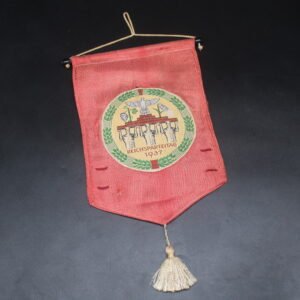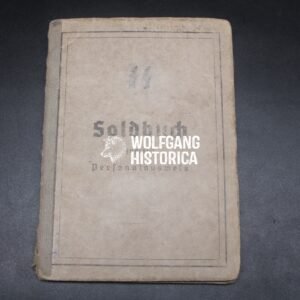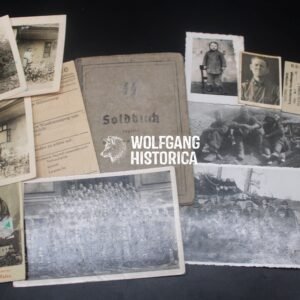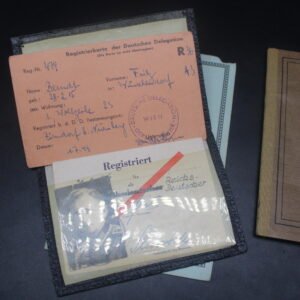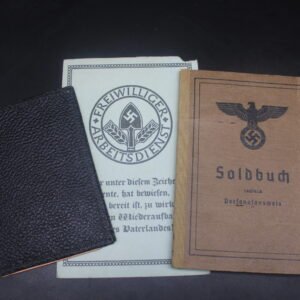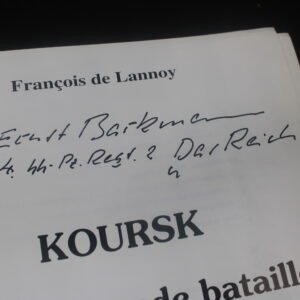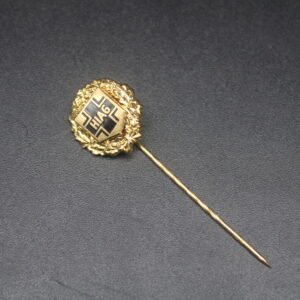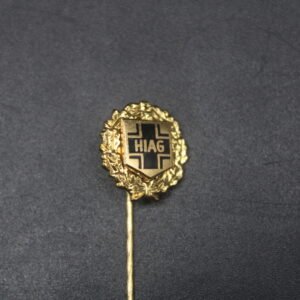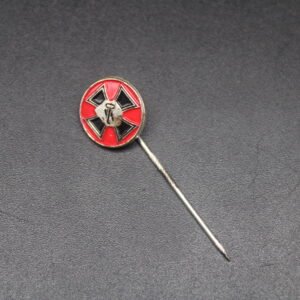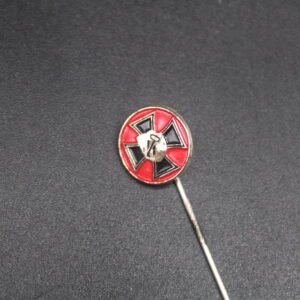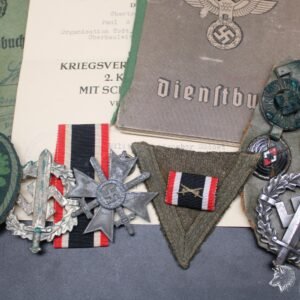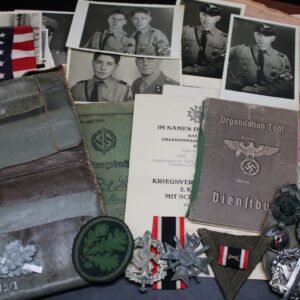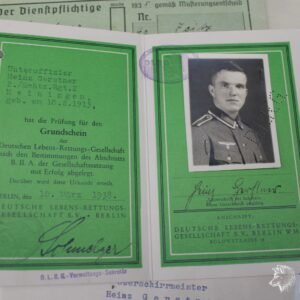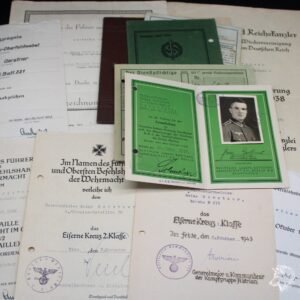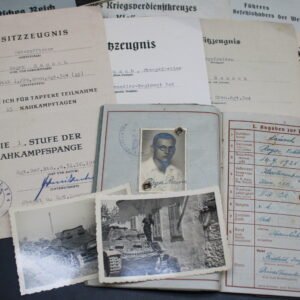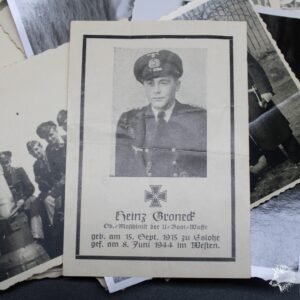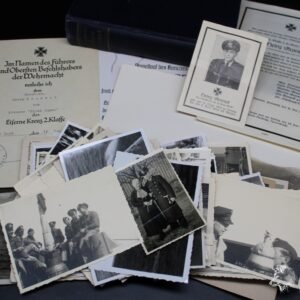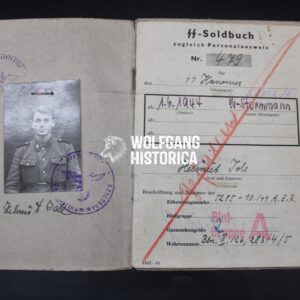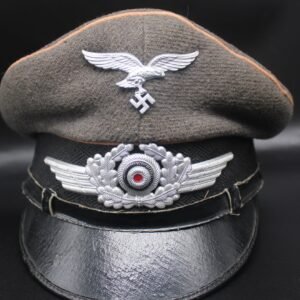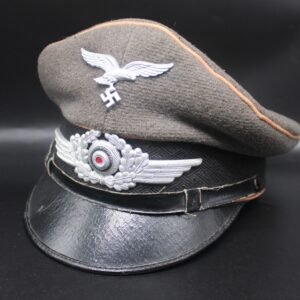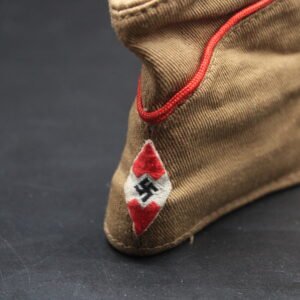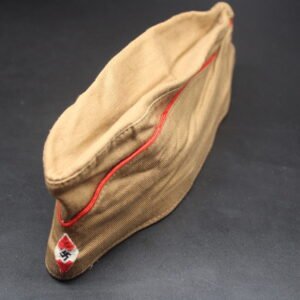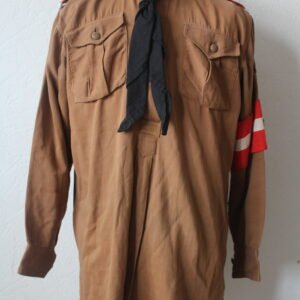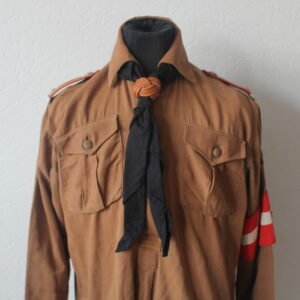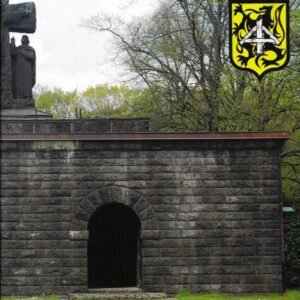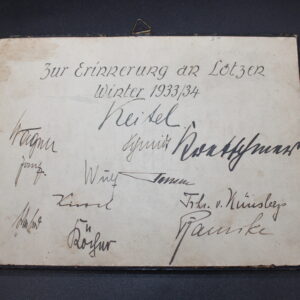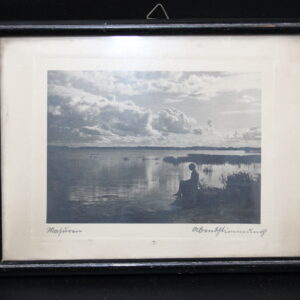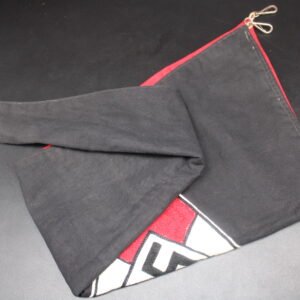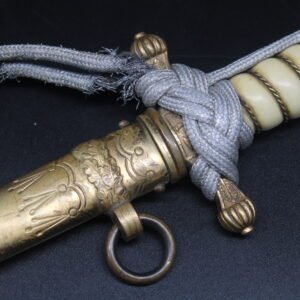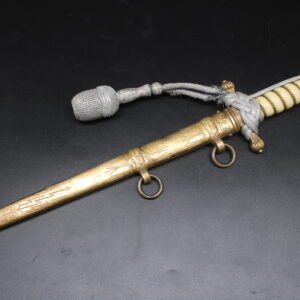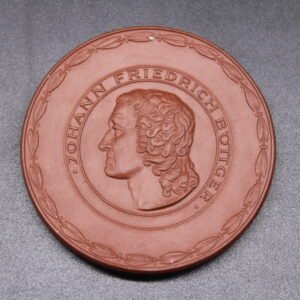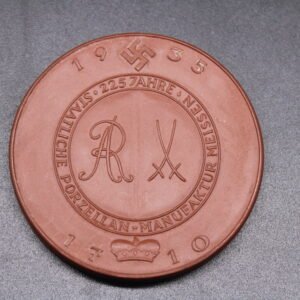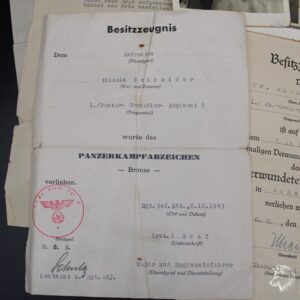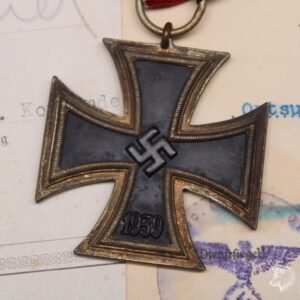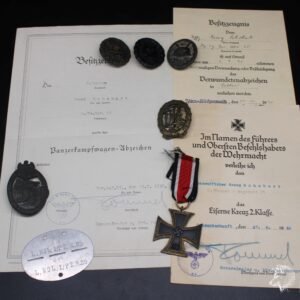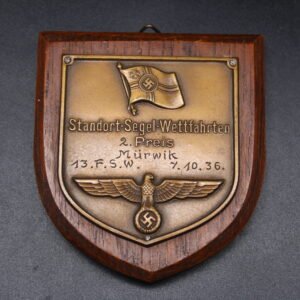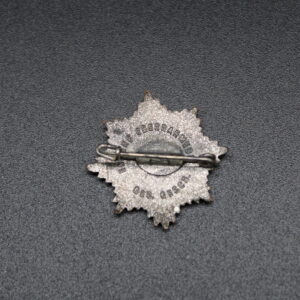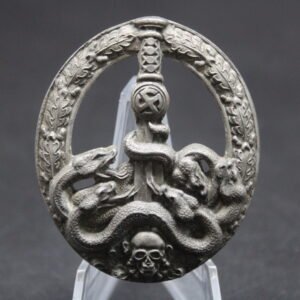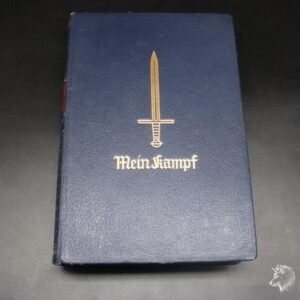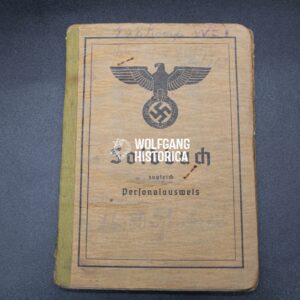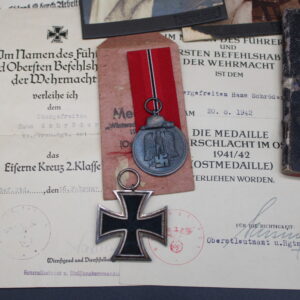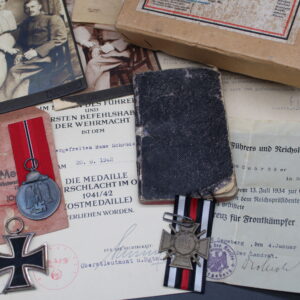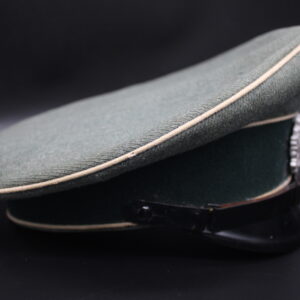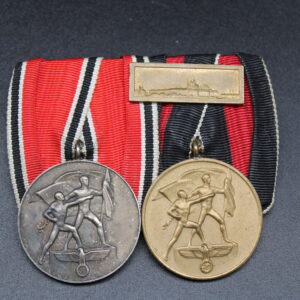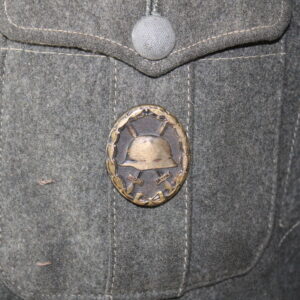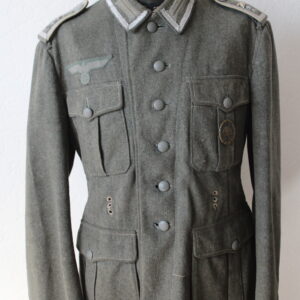DRK (Deutsches Rotes Kreuz) 2nd Model Schiffchen — Overseas Cap
€295,00Waffen-SS Wehrpass & Stammkarte — SS-Panzer-Artillerie-Regiment 1 “LAH” — KIA Falaise Pocket 1944
€1.450,00Recipient: SS-Sturmmann Karl Baldischwieler
Unit: 5. Batterie / SS-Panzer-Artillerie-Regiment 1 “Leibstandarte Adolf Hitler”
Division: 1. SS-Panzer-Division “LAH”
Contents
-
Original SS-Wehrpass — well-documented, includes photo
-
SS-Stammkarte
Service History
-
Training: SS-Artillerie-Ersatz-Regiment
-
Transfer: To 5./SS-Panzer-Artillerie-Regiment 1 (LAH) in June 1943
-
Campaigns:
-
Italy (1943)
-
Eastern Front (late 1943–early 1944)
-
France, Battle of Normandy (summer 1944)
-
-
Promotion: Advanced to SS-Sturmmann during combat, 21 June 1944
-
Fate: Killed in Action on 20 August 1944 near Saint-Lambert-sur-Dives during the closing stages of the Falaise Pocket
Historical Context: The Falaise Pocket
The Battle of the Falaise Pocket (August 12–21, 1944) marked the decisive end of the German presence in Normandy. Surrounded by Allied forces, elements of the 7. Armee and 5. Panzerarmee—including divisions of the Waffen-SS—were encircled near Falaise, Trun, and Chambois.
-
Over 50,000 German troops were trapped, with thousands killed and vast amounts of equipment destroyed.
-
Saint-Lambert-sur-Dives, where Baldischwieler fell, became one of the last escape corridors and saw fierce, desperate fighting as units of the LAH, Hitlerjugend, and other formations tried to break out.
-
Baldischwieler’s death on 20 August 1944 places him among those who perished in the final collapse of the German front in Normandy.
Condition
-
As seen in photos: Wehrpass complete, with photo and wartime entries.
-
Stammkarte included, further strengthening provenance.
Collector’s Notes
-
A poignant and historically significant KIA Normandy grouping tied to the elite Leibstandarte Division.
-
Direct connection to the dramatic fighting and destruction of German forces in the Falaise Pocket, one of the key turning points of the Western Front in 1944.
-
Rare opportunity to acquire an SS-Wehrpass with Normandy and Falaise attribution.
Leon Degrelle – 28. SS-Freiwilligen-Panzer-Grenadier-Division “Wallonië”
€250,00Framed Signed Postcard of SS-Obergruppenführer Wilhelm Reinhard
€350,00Hitlerjugend Armband
€180,00SA/NSDAP Party Sleeve Armband
€175,00Original NSDAP Reichsparteitag 1937 Table / Wall Flag
€495,00Original NSDAP Reichsparteitag 1937 Table / Wall Flag (Fahrradfahne)
Patriotic-style double-sided table/wall flag issued for the 1937 Reichsparteitag in Nürnberg.
-
One side shows three men holding a statue of the Reichsadler with the text “Reichsparteitag 1937” (multi-colored woven design with green rim).
-
Reverse shows a woven town view of Nürnberg.
-
Measures approx. 18.5 cm x 12.5 cm, made of bright red linen (minor sun fading, light age staining, no major damage).
-
Still retains its attachment construction for mounting
-
With four original cloth tabs (Laschen) likely meant for attaching commemorative tinnies from the rally.
Overall a scarce and decorative rally souvenir — well-preserved, lightly used, and rarely encountered.
Rare Soldbuch & Personal Grouping — SS-Panzer-Pionier-Bataillon 11 “Nordland” (Died in Captivity)
€1.995,00Grouping belonging to SS-Sturmmann Johann Schmid, who served with the 3. Kompanie / SS-Panzer-Pionier-Bataillon 11 of the famed 11. SS-Freiwilligen-Panzergrenadier-Division “Nordland.”
Contents
-
Soldbuch
-
Opened by Stubaf. Hermann Voß (Kdr. Pi.Btl. 11)
-
Contains entries for his awards and service
-
Final entries signed by notable officers (see below)
-
-
Wound Tag (for grenade splinter wound at Narwa)
-
Photo of Schmid in uniform
-
Two rare photographs of “Orphanage Hill,” Narwa
-
Extremely famous position in SS history during the Narwa fighting
-
-
SS-Schule Prag (Pioneer school) training photo
-
Family photos & train tickets
Awards & Service
-
Verwundetenabzeichen in Schwarz (Wound Badge in Black)
-
Eisernes Kreuz 2. Klasse (Iron Cross 2nd Class)
-
Wounded at Narwa (grenade splinter to face/feet)
-
Likely captured during the Battle of Berlin and later died in captivity.
Officer Signatures & Provenance
-
Stubaf. Hermann Voß — Kdr. Pi.Btl. 11 (opened the Soldbuch, April 1945)
-
Ostuf. Fritz Gärdtner — 2./Pi.Btl. 11 (signed Dec. 1943 check; KIA July 1944 at Auvere)
-
Ustuf. Hans Henseler — Chef, 3./Pi.Btl. 11 (signed last check & EK2 entry, Oct. 1944)
Historical Significance
-
Rare grouping tied directly to Narwa 1944, including photographs of the legendary Orphanage Hill — among the most iconic battle sites in the defense of the Narwa Front.
-
Strong divisional connection to the “Nordland” Division, heavily involved on the Eastern Front and in the final battles around Berlin.
-
Includes both frontline material (Soldbuch, wound tag, Narwa photos) and intimate personal effects (family photos, travel tickets) that bring the soldier’s story to life.
Condition
-
As seen in photos: authentic, untouched grouping with natural period wear.
-
Soldbuch complete with photo, legible entries, and proper stamps.
Soldbuch, RAD Pass — “Spieß” in Panzer-Regiment 3 (5x Awards)
€250,00Recipient: Hauptfeldwebel Berndt
Role: “Spieß” (company first sergeant) of the Stabskompanie / Panzer-Regiment 3, 2. Panzer-Division
Grouping Includes
-
Soldbuch
-
Complete with original photograph
-
Very well filled in with entries and awards
-
-
Arbeitsdienst Pass (RAD)
-
Wehrmacht ID Card
Service History
-
Served through the Invasion of Poland (1939)
-
Took part in the Western Campaign, 1940–41 with the 2. Panzer-Division
-
Senior NCO as company “Spieß” in the regimental staff company
Decorations Recorded
-
Dienstauszeichnung IV. Klasse (Long Service Award)
-
Erinnerungsmedaille an den 13.3.1938 (Annexation of Austria Medal)
-
Erinnerungsmedaille an den 1.10.1938 (Sudetenland Medal)
-
Schützenabzeichen 3. Klasse (Marksman’s Badge)
-
Kriegsverdienstkreuz 2. Klasse mit Schwertern (War Merit Cross 2nd Class with Swords)
Collector’s Notes
-
Excellent complete set with strong documentation trail.
-
The Soldbuch is especially desirable: photo included, thorough entries, showing service from the earliest campaigns of the war.
-
Attractive set tied to a senior NCO in the famed 2. Panzer-Division.
Condition
-
As seen in photos: period wear but well-preserved; Soldbuch intact with photo, legible entries throughout.
Book La Bataille de Koursk — Éditions Heimdal (13x Signed W-SS Panzer RK/DKIG..!)
€350,00Original La Bataille de Koursk — Éditions Heimdal (Original French Edition) — book which bears several top signatures! This copy has been signed by veterans who either earned the Ritterkreuz, Deutsches Kreuz in Gold, or served during the Battle of Kursk. Notable names:
-
Ernst Barkmann
-
Hans Siptrott
-
Karl-Heinz Boska
-
Walter Lau
-
Fritz Langanke
-
Rudolf von Ribbentrop
-
Josef “Sepp” Lainer
-
Walter Scherf
-
Wilhelm Wiener
-
Leonhard Klemz
-
Richard Rudolf
-
Kurt Sametreiter
-
Plus one additional unidentified veteran signature
Rarely encountered ! Condition as seen.
HIAG (Hilfsgemeinschaft auf Gegenseitigkeit) Golden HIAG Honor Pin
€80,0012. SS-Panzer-Division “Hitlerjugend” Veteran Association Stickpin
€125,00Exceptional Father–Son Grouping – SA, Organisation Todt & U.S.-Born Ski-Jäger Soldier
€995,00A truly remarkable and rare family grouping spanning two generations, with service in both the Sturmabteilung (SA) and Organisation Todt, as well as elite Ski-Jäger front-line combat.
The father served in the SA and later with the Einsatzgruppe Oberbauleitung Skopje of the Organisation Todt. His son — notably born in Cleveland, Ohio, USA — returned to Germany and served with the 13. Kompanie / Ski-Jäger-Regiment 1, 1. Ski-Jäger-Division, a specialized mountain and winter warfare unit.
Highlights include:
-
Several superb portrait photographs of the son in Hitlerjugend uniform, plus family photos.
-
A rare Ski-Jäger cap badge (two piece!) mounted on an old leather document bag.
-
Original Jäger cloth insignia.
-
Medals and awards of the son: Wound Badge, Hitlerjugend Shooting Badge, Hitlerjugend Proficiency Badge in Silver, 2x SA Sports Badge in Silver, rank insignia.
-
The father’s War Merit Cross 2nd Class (KVK2).
-
A small U.S. flag, possibly brought with him from America before or during the war — a tangible link to his unusual birthplace and journey to Germany.
Condition: As seen, with genuine period wear and patina.
An extraordinary and historically fascinating grouping, combining political, construction, and combat service — and with the rare twist of a U.S.-born Wehrmacht soldier in an elite winter warfare division.
Grouping to Leutnant Heinz Gerstner – Pionier-Bataillon 38 & 221 (Scarce “Kampfgruppe Aldrian” EK1 Doc!)
€550,00Grouping to Leutnant Heinz Gerstner – Pionier-Bataillon 38 & 221
A fine and complete award and document grouping to Leutnant Heinz Gerstner, spanning his service from the early campaigns of 1939 to 1943, with multiple signed documents by highly decorated officers.
Highlights include:
-
Eisernes Kreuz 2. Klasse (1939) – Award document dated 03.11.1939, signed by Generalleutnant Rudolf Veiel (Ritterkreuzträger). Early war signature from a highly respected commander.
-
Eisernes Kreuz 1. Klasse (1939) – Award document dated 08.02.1943, signed by Generalmajor Eduard Aldrian (Deutsches Kreuz in Gold). This EK1 award stems from Kampfgruppe Aldrian, making it a particularly scarce and desirable document for collectors of Eastern Front and unit-specific award paperwork.
-
Medaille zur Erinnerung an den 13. März 1938 (Anschlussmedaille) – Award document.
-
Allgemeines Sturmabzeichen – Award document.
-
Medaille “Winterschlacht im Osten 1941/42” (Ostmedaille) – Award document.
-
Dienstauszeichnung der Wehrmacht 4. Klasse – Award document.
-
Medaille zur Erinnerung an den 1. Oktober 1938 (Sudetenland-Medaille) with clasp “PRAGER BURG” – Award document.
-
The last two certificates above signed by Major Wilhelm Wassung.
-
Sports Awards:
-
Deutsches Reichssportabzeichen in Bronze – Achievement booklet with photograph in place.
-
SA-Sportabzeichen in Bronze – Achievement booklet with photograph in place.
Additional Material:
-
Various Wehrmacht ID cards and personal documents connected to Gerstner’s career.
This grouping offers a rare combination of early and mid-war decorations, sports awards, and personal paperwork, anchored by the scarce EK1 document from Kampfgruppe Aldrian — a must-have for serious collectors of Pionier units and Eastern Front award documentation.
Exceptional Family Grouping – Hauptmann Friedrich Rausch (Died) & Unteroffizier Roger Rausch (KIA)
€950,00A rare and deeply personal father-son grouping, offering a unique glimpse into two generations of Wehrmacht service. This combined lot honors the military legacy of Hauptmann Friedrich Rausch, a WWI veteran and rear-echelon officer during WWII who died during the war in 1944, and his son, Unteroffizier Roger Rausch, a decorated Panzergrenadier killed in action in 1943 on the Eastern Front.
Grouping to Hauptmann Friedrich Rausch – WWI Veteran & WWII Officer
Served with Landesschützen-Ersatz-Bataillon 17, responsible for home-front security and reserve duties.
Highlights:
-
Award document for the 1939 War Merit Cross 2nd Class with Swords, dated 17.12.1940, including the original proposal for the decoration.
-
Award document for the Honor Cross of WWI, dated 05.12.1939, hand-signed.
-
Heer aluminum EM/NCO parade buckle with leather belt (shortened, replaced catch), showing clear age and character.
-
Original military ID tag (aluminum).
-
Heer single shoulder board for a Hauptmann in Infanterie-Regiment 132 (sewn-in type).
-
Heer officer’s aiguillette.
-
A selection of period documents adding context and depth.
A solid example of a decorated, long-serving officer who bridged both world wars.
Grouping to Unteroffizier Roger Rausch – KIA Panzergrenadier, Pz.Gren.Rgt. 304
Roger Rausch served with Panzer-Grenadier-Regiment 304 and was killed in action on 22.10.1943 near Wosok, during fierce engagements on the Eastern Front. His grouping is a vivid testament to front-line service and sacrifice.
Decorations (all with original award documents):
-
Close Combat Clasp in Bronze, issued 31.10.1943, hand-signed by Oberst Gerhard Schmidhuber (RK with Oak Leaves).
-
Tank Assault Badge in Bronze, issued 24.09.1942, hand-signed by Oberst von Goerne.
-
1939 Iron Cross 2nd Class, issued 13.09.1943, hand-signed by Generalleutnant Vollrath Lübbe (RK winner).
-
Wound Badge in Black, issued 25.09.1942, hand-signed by a Major.
Also included:
-
Wehrpaß, issued 03.02.1939 with original photo. Lists all major decorations and campaigns from 10.05.1940 to 26.09.1942. Returned to his father on 04.01.1944.
-
Five original photographs, including one showing Roger’s grave.
-
His Wehrmacht-issue eyeglasses with case.
-
German Reich ID card, 2 additional period documents.
-
A Heer EM/NCO side cap eagle with cockade.
Signs of use and age throughout, making this a rich, field-worn ensemble.
A Rare and Emotional Family Legacy
This grouping tells a powerful story of two soldiers — one a WWI veteran who lived to see his son go to war, the other a front-line Panzergrenadier who paid the ultimate price. The combination of high-quality award documents, signed by high-ranking and highly decorated commanders, along with personal effects such as letters, photos, and military accessories, make this grouping not only historically valuable but emotionally compelling.
A unique opportunity to own a multi-generational Wehrmacht grouping, complete with excellent documentation, signatures, and a tragic yet honorable narrative.
Interesting Grouping – Oberfeldwebel Heinemann, 19. Panzer-Division – KIA Warsaw Uprising 1944!
€850,00A poignant and historically important grouping to Oberfeldwebel Heinemann, a veteran NCO of the 2. Kompanie / Panzer-Aufklärungs-Abteilung 19, 19. Panzer-Division, who was mortally wounded in combat during the ferocious fighting of the Warsaw Uprising.
Heinemann was severely wounded on 29 September 1944 in Warsaw during the unit’s brutal house-to-house fighting to crush the Polish resistance. Despite medical treatment, he succumbed to his wounds on 7 October 1944. The 19. Panzer-Division had been redeployed into the city specifically to combat the uprising, and its Panzer-Aufklärer fought deep into the heart of Warsaw.
Decorations:
-
Wehrmacht Dienstauszeichnung up to the II. Klasse
-
Ostmedaille
-
Kriegsverdienstkreuz 2. Klasse
-
Verwundetenabzeichen in Schwarz
-
Eisernes Kreuz 2. Klasse
Grouping includes:
-
All original award documents
-
Wehrpass documenting his service
-
Period photographs
-
Letters from his doctor and comrades to the family reporting on his wounding and death
-
Additional related papers
Why this grouping stands out:
Groupings to soldiers killed during the Warsaw Uprising are extremely scarce. This set not only connects directly to the historically significant and politically charged events of late 1944 but also represents a decorated veteran NCO of an elite Panzer-Aufklärungs unit engaged in some of the most intense urban combat of WWII.
A rare opportunity to acquire a well-documented, wartime grouping tied to the crushing of the Warsaw Uprising, complete with exceptional provenance and personal history.
Rare Kriegsmarine Grouping – Obermaschinist Heinz Groneck – Prinz Eugen & U-970 – KIA on June 8, 1944
€0,01A historically significant original grouping belonging to Obermaschinist Heinz Groneck, a veteran of both the famed heavy cruiser Prinz Eugen and the German U-Boat service.
Includes:
-
Award document for the Eisernes Kreuz 2. Klasse (Iron Cross 2nd Class)
-
Original wartime copy of Mein Kampf
-
Death card of Heinz Groneck
-
Period photograph group featuring Groneck and comrades
Service History
Heinz Groneck began his naval career aboard the heavy cruiser Prinz Eugen, one of the most famous German warships of WWII. Commissioned in 1940, Prinz Eugen took part in Operation Rheinübung alongside Bismarck in May 1941 and later served in both the Atlantic and Baltic theatres, surviving numerous engagements and heavy damage.
Following his surface fleet service, Groneck volunteered for the U-Bootwaffe and was posted to U-970, a Type VIIC submarine. These boats were the workhorses of the Kriegsmarine submarine arm, tasked with disrupting Allied shipping lanes.
Final Mission & Fate
On 8 June 1944, just two days after the Allied landings in Normandy, U-970 was operating near the French coast when she was attacked by British forces. The submarine was sunk with heavy loss of life — including Heinz Groneck. His service and sacrifice are commemorated in the accompanying death card.
Why This Grouping is Special
-
Direct connection to two iconic branches of the Kriegsmarine – surface fleet and U-Boat service
-
Contains personal, named items including award document and death card
-
Links to two historically significant warships: Prinz Eugen and U-970
-
Represents the transition from Germany’s capital ships to the desperate submarine war of the final years
Condition: All items are original and in good condition for their age, as shown in the photos.
A poignant and rare collection — ideal for serious collectors of U-Boat history, Kriegsmarine memorabilia, or WWII naval history.
SA-Wehrmannschaft Uniform Set – SA-Truppführer, Marine/Motor Units
€2.250,00A rare and complete SA-Wehrmannschaft uniform set, featuring a tunic with the rank of SA-Truppführer. The uniform is fitted with Marine branch shoulderboards and collar tabs for Motor units, both originally period-stitched to the tunic along with the SA armband.
The tunic retains a size stamp and shows traces of a washed-out maker’s label on the inside. The set also includes an SA-Wehrmannschaft greatcoat and matching trousers. The trousers show signs of service use, with replaced buttons and some ink stains, adding to the authentic field-worn character of the ensemble.
This grouping offers an appealing blend of rank, branch, and unit specialization, making it a fine representative example of the SA-Wehrmannschaft. Original stitching to insignia and armband further enhance its desirability to collectors.
Condition as seen. This item is being sold on behalf of a consignor.
A seldom-offered, complete SA-Wehrmannschaft set—ideal for display in a WWII political organization collection or as part of a broader German uniform display.
Shipping might not be final to some countries due weight.
Exceptional & Rare Panzer Grouping – Normandy & Ardennes – Panzer-Regiment 3 of 2. Panzer-Division!
€1.995,00Exceptional & Rare Panzer Grouping – Normandy & Ardennes – Obergefreiter Gärtner, 2. Panzer-Division
A truly outstanding and rare Panzer grouping to Obergefreiter Gärtner, who served with the 8. Kompanie / Panzer-Regiment 3, later the 6. Kompanie / Panzer-Regiment 3, and finally in the closing stages of the war with the Werkstattkompanie. Most significantly, Gärtner fought in Normandy with the infamous 2. Panzer-Division, earning several battle days in July 1944 — a distinction rarely documented so clearly.
In August 1944, during the ferocious fighting in Normandy, he was wounded and subsequently decorated with the Iron Cross 2nd Class (Eisernes Kreuz 2. Klasse) for his actions. His earlier awards included the Wound Badge in Black (Verwundetenabzeichen in Schwarz) and the Panzer Assault Badge in Silver (Panzerkampfabzeichen in Silber), both earned before Normandy.
This grouping comes complete with an array of historically significant items:
-
Soldbuch with matching Erkennungsmarke (dog tag)
-
Wehrpass
-
Original award documents for the VWA Schwarz and Panzerkampfabzeichen
-
Several documents relating to training and his wounding
-
Original recommendation file for the awarding of the Panzerkampfabzeichen in Silber
-
Additional paper listing more battle days, including at Hottot, Normandy — matching details in his Soldbuch
Why this grouping stands out:
Groupings to Panzer personnel who fought in Normandy are exceptionally scarce, and this set offers direct, verifiable combat connection to both Normandy and Ardennes operations. The inclusion of the Soldbuch, Wehrpass, matching Erkennungsmarke, award citations, and unique battle day documentation makes this an exceptional historical offering for the advanced collector.
A rare opportunity to acquire a complete, Normandy-provenanced Panzer grouping from one of the most famous German armored divisions of WWII.
KIA SS-Soldbuch SS-Panzer-Artillerie-Regiment “Hitlerjugend” (Normandy!)
€1.995,00Mutterkreuz in Gold – Mother’s Cross in Gold (Friedrich Linden)
€100,00Luftwaffe NCO Nachrichten Visor Cap (Flemish-Made in Occupied Belgium!)
€0,01An outstanding and rare example of a Luftwaffe NCO visor cap for Nachrichten (Signals) personnel, featuring the distinctive gold-brown piping specific to the branch. What sets this cap apart is its occupation-period construction—manufactured in Belgium, most likely Flanders, based on the unmistakable Flemish tailoring style and the classic locally produced Luftwaffe eagle insignia.
This cap is a large size (58½) and shows beautiful, honest wear with a nicely aged patina, reflecting real field or service use without excessive damage. The visor, sweatband, and lining all display period-appropriate materials and construction methods consistent with wartime Flemish-made headgear.
A rarely encountered piece combining Luftwaffe field branch identification with the added historical value of local Flemish manufacture under German occupation—making it a must-have for collectors of foreign-made or occupation-period uniforms.
Condition as shown. A visually striking and historically intriguing cap.
This item is being sold on behalf of a consignor.
Medal Bar: Iron Cross 2nd Class, Honor Cross & 25 Years Loyal Service
€140,00Hitlerjugend Summer Cap with RZM Tag
€350,00Excellent example of a genuine Hitlerjugend Sommermütze (summer cap), complete with the cloth HJ diamond insignia on the front. The interior is size-marked "55", and retains the original RZM tag, confirming its authenticity and regulation issue.
This cap presents in honest, used condition, showing appropriate wear consistent with age and service.
Stunning Complete Hitlerjugend Uniform – Oberkameradschaftsführer, Bann 188 Nord Hamburg
€1.100,00A truly beautiful and complete Hitlerjugend brown shirt uniform set, steeped in authenticity and character. This ensemble includes all key elements: the HJ triangle for Nord Hamburg, shoulderboards, HJ armband, scarf, and original knot—everything you'd hope for in a fully presented HJ uniform.
The shoulderboards display the rank of Oberkameradschaftsführer and are fitted with pressed metal "6" numerals, marking this as belonging to Gefolgschaft 6 of Bann 188—a unit from the Nord Hamburg region, perfectly matching the Gebietsdreieck (regional triangle). Bann 188 was part of the Hamburg structure of the Hitlerjugend, falling under Gebiet 10, a known and highly collected region due to its size and significance within the organization.
This shirt tells a story: it shows honest wear and tear, which many collectors (myself included) value for its character and originality. There are field repairs present—testament to real use rather than museum staging. The HJ armband is machine-sewn but with some loose stitching visible on the edges. The shirt is RZM-unmarked, which is not uncommon for field-worn or early transitional uniforms.
Whether you're a serious collector or curating a display focused on youth organizations in the Third Reich, this is a rare and complete set—hard to find with such cohesion between insignia, rank, and regional assignment.
A truly desirable and visually impressive piece that would stand out in any collection. Condition as seen!
Vlaamse Soldatengraven in Lommel (Private Published)
€13,00Framed Picture with Lots of TOP Signatures! (Keitel, Ramcke, Wagner..)
€650,00Large Wimpel of the BDM/JM Upstedt
€650,00Kriegsmarine Dagger with Portepee by Eickhorn
€0,01Original Kriegsmarine officer's dagger, complete with its original portepee, manufactured by the renowned firm Eickhorn of Solingen. This classic naval dagger is a fine example of Third Reich period craftsmanship and remains in overall nice condition.
The blade is bright and clean with only light wear, featuring the iconic Eickhorn maker's mark, and retains its full etched fouled anchor motif on both sides. The gilded brass fittings show a warm, even patina consistent with age, while the celluloid grip is intact and free of cracks. The portepee is original to the piece and still tied in the correct naval knot style, showing some honest wear but complete.
The scabbard retains good detail with minor handling wear, displaying a nicely toned finish.
Sold to people over 18+ with proof of identity!
1935 Meissen 225th Anniversary Böttger Stoneware Medallion
€55,00Original commemorative medallion issued in 1935 to celebrate the 225th anniversary of the founding of the Staatliche Porzellan-Manufaktur Meissen, the world-renowned German porcelain manufacturer established in 1710. Crafted in Böttgersteinzeug (Böttger stoneware), this elegant red-brown medallion honors Johann Friedrich Böttger, the alchemist credited with discovering the first European hard-paste porcelain.
Obverse:
-
Classical profile of Böttger in high relief, encircled by a laurel wreath and the inscription:
"JOHANN FRIEDRICH BÖTTGER"
Reverse:
-
Commemorative text: “Staatliche Porzellan-Manufaktur Meissen – 225 Jahre – 1710–1935”
-
Features Meissen's iconic crossed swords mark, AR monogram, and a crown symbol.
-
Includes a swastika and date “1935,” reflecting the political era of production.
This piece is a unique blend of artistic, historical, and political significance, representing a key milestone in European ceramics and the legacy of Meissen craftsmanship. An excellent addition for collectors of Meissen porcelain, Third Reich memorabilia, or ceramic art history.
Top German WWI & WWII Medal Bar – 6x Ordenspange with 25-Year Wehrmacht Service Cross!
€0,01-
Iron Cross 2nd Class 1914
-
Awarded in the German Empire during World War I.
-
The cross bears the “W” for Kaiser Wilhelm and the year 1914.
-
-
Merit Cross for War Aid (Kriegs-Hilfsdienstkreuz)
-
Issued during World War I to civilians and military personnel who contributed to the war effort.
-
-
War Merit Cross 2nd Class with Swords
-
Awarded for merit under wartime conditions, but not necessarily for direct combat.
-
-
Honor Cross of the World War 1914–1918 (Hindenburg Cross)
-
Awarded to World War I veterans by the Third Reich in the 1930s.
-
-
Wehrmacht Service Award for 25 Years
-
Awarded to Wehrmacht personnel for 25 years of military service.
-
-
Wehrmacht Service Award for 12 Years
-
Awarded to Wehrmacht personnel for 12 years of military service.
-
These medals are mounted together as a "medal bar" (Ordenspange), commonly worn on uniforms for formal occasions. This particular set likely belonged to a veteran who served in both World Wars and had a long military or public service career.
Condition as seen!
Tragic Award Doc Set of Panzergrenadier-Regiment 6 (7. Panzer-Division)
€175,00Exceptional Panzer-Regiment 25 Grouping – Signatures of Erwin Rommel “The Desert Fox”!
€0,01Offering an original, outstanding and historically significant grouping from a decorated Panzer soldier, Unteroffizier Schobert who served with the 2. Kompanie/ Panzer-Regiment 25 of the 7. Panzer-Division ("The Ghost Division"), featuring three award certificates — two of which are hand-signed by none other than Erwin Rommel, also known as the legendary “Desert Fox” and the soldier's awards and dogtag. This rare set represents a true centerpiece for any advanced WWII militaria collection!
Grouping Includes:
-
Award Certificate for the Panzerkampfabzeichen in Silber – Hand-signed by Generalfeldmarschall Erwin Rommel, which is one of the most highly sought-after signatures, from one of Germany’s most iconic commanders. Earned during the Western Campaign in 1940.
-
Award Certificate for the Eisernes Kreuz 2. Klasse (Iron Cross 2nd Class) – Also hand-signed by Erwin Rommel, adding even more immense historical and collector value. Earned also during the Western Campaign in 1940.
-
Award Certificate for the Verwundetenabzeichen in Silber
-
Erkennungsmarke (ID Tag) – giving personal identity to the recipient.
-
Panzerkampfabzeichen in Silber
-
Eisernes Kreuz 2. Klasse (Juncker made) – A premium variant from one of the most respected manufacturers.
-
2x Verwundetenabzeichen in Schwarz (1st Model) – Early war version.
-
Verwundetenabzeichen in Silber – Awarded for multiple wounds or one severe wound.
-
DRL Sports Badge – Prewar athleticism and military preparedness represented in this finely made piece.
Highlights:
-
Two rare Rommel signatures – Authentic, crisp, and with impeccable provenance.
-
Complete and coherent grouping – All items traceable to one soldier, offering both historical depth and display impact.
-
Premium award pieces – Juncker EK2, early wound badges, and matching paperwork.
This is more than a grouping—it's a time capsule of bravery, elite service, and personal history, anchored by the signature of one of WWII’s most iconic field marshals. A rare opportunity for collectors to acquire a museum-grade ensemble with immense investment and display potential.
Kriegsmarine Sailing Competition Prize – Mürwik 1936
€160,00Wehrmacht Panzer Visor Cap – Fhr. v. Süsskind-Schwendi (PJA38, Pz.Gren.Rgt.304 and Afrika-Btl. 28!)(Captured in North-Africa!)
€2.250,00Reichsluftschutzbund (RLB) Mitgliedsabzeichen (Marked “H. Aurich Dresden”)
€45,00Reichsluftschutzbund (RLB) Mitgliedsabzeichen (Marked “Enders Oberrahmed”)
€45,00Bandenkampfabzeichen in Bronze (C.E. Juncker, Berlin)
€3.995,00TOP Waffenrock Spieß Infanterie-Regiment 65 (22. Luftlande-Division, Holland 1940!)
€0,01Mein Kampf “50 Years Anniversary” Edition
€0,01Waffen-SS KC Holders book filled with ca. W-SS 140 Signatures!
€1.995,00Grouping of Artillery Officer (MP40! 7x Awards)
€0,01Award Doc Set of Panzer-Pionier-Bataillon 32 & Minenkommando Danmark (As seen in Movie “Land of Mine”!)!
€450,00- Award document for the Eisernes Kreuz 2. Klasse
- Award document for the Eisernes Kreuz 1. Klasse
- Award document for the Verwundetenabzeichen in Schwarz
- Award document for the Winterschlacht im Osten 1941/42
- Several photographs
- Booklet with clean-ups of his mine clearing in August 1945!
- Extra papers
Awards & Document Set of Father & Son (KIA)
€0,01Wehrmacht Kavallerie-Regiment 13 Waffenrock (Lüneburg)
€0,01Wehrmacht Infanterie Visor Cap for EM/NCO (Carl Isken, 1939)
€0,01Medal Bar with Annexation of Austria & Sudetenland + Bar !
€0,01M41 Uniform Feldwebel MG-Bataillon 9 (Stalingrad)
€0,01Product Status
All Categories
- Combat Awards
- Documents
- Erkennungsmarke
- Flemish Collaboration
- General Awards
- Iron Cross
- Japanese Militaria
- Photos
- Porcelain & Cutlery
- Stickpins & Tinnies
- Uniforms
- Wartime Signed
- Wound Badges
- Archive (Sold)
- Awards & Decorations
- Uniforms & Insignia
- Papers & Documents
- Award Documents
- Military & Civil ID's
- Literatur
- Photos & Postcards
- Signatures
- Panzer
- Waffen-SS
- Wehrmacht
Brands
- Adolf Baumeister (Lüdenscheid)(1)
- Arbeitsgemeinschaft Metall und Kunststoff (Gablonz an der Neiße)(1)
- Arno Wallpach (Salzburg)(2)
- C.E. Juncker (Berlin)(5)
- Carl Wild (München)(2)
- Förster & Barth (Pforzheim)(2)
- Friedrich Linden (Lüdenscheid)(2)
- Friedrich Orth (Wien)(1)
- Fritz Zimmermann (Stuttgart)(1)
- Hauptmünzamt Wien (Wien)(2)
- Hermann Aurich (Dresden)(1)
- Klein & Quenzer (Idar Oberstein)(3)
- Paul Meybauer (Berlin)(2)
- Rudolf Souval(2)
- Rudolf Wächtler & Lange (Mittweida)(4)
- Wernstein (Jena)(3)
- Wilhelm Deumer (Lüdenscheid)(6)
- Wilhelm Hobacher (Wien)(1)

